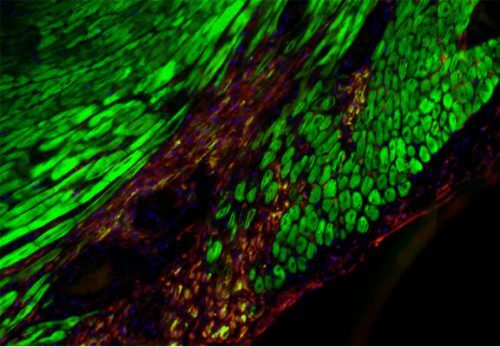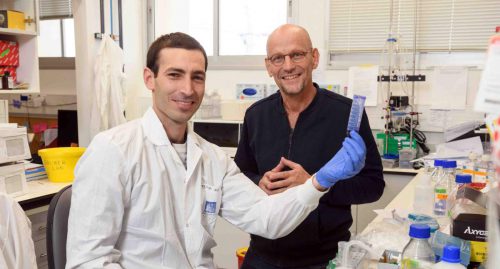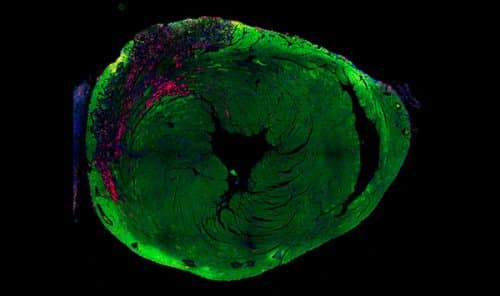Weizmann Institute scientists discovered that a small blue molecule improves heart function in mice that have had a heart attack

"Blue blood" was for years a nickname for aristocracy, but it may become a code name for a new treatment for heart patients. Weizmann Institute of Science scientists have discovered that a small molecule used as a blue dye in biological laboratories helps repair damaged heart tissue in mice. The results of the study were recently published in the scientific journal Journal of Clinical Investigation (JCI) Insight.
The research began a few years ago when members of Prof. Eldad Tzhor's research group in the Department of Molecular Biology of the Cell grew heart muscle cells, called cardiomyocytes, in laboratory plates, hoping to identify potential drugs that would lead to the regeneration of damaged heart cells or the growth of new cells. The researchers teamed up with Dr. Haim Bar and Dr. Nega Kotzer in the HTS unit at the Nancy and Steven Grand Israeli National Center for Personalized Medicine at the Weizmann Institute of Science and with the help of robotic systems, dispersed the heart muscle cells they had grown into thousands of tiny test tubes and added a small molecule to each test tube - Biochemical compounds that are a preferred means of developing new drugs due to their cheap price, stability and the fact that our immune system does not work against them. After following the cells for six days and counting them, it became clear that one of the compounds led to an increase in the number of heart muscle cells: it was a molecule of a dye called "Chicago Sky Blue" (CSB) that is usually used as a research and diagnostic tool.

In the current study, the researchers tested the molecule under real conditions in heart attack models in mice. Similar to humans, heart attacks in adult mice lead to the formation of scar tissue. Heart cells in mammals are strong enough to work continuously for decades - and therefore do not regenerate. However, when they are damaged, it is irreversible. The researchers, led by research student Oren Yifa, injected CSB into the hearts of mice that had heart attacks, and found an improvement in cardiac function. Encouraged by this finding, they looked for evidence of heart cell regeneration in mice - but found nothing.
How, then, did CSB help improve cardiac function? The researchers hypothesized that the substance may suppress certain types of inflammation that occur in response to damage to the heart, and may lead to continued scarring - a vicious cycle that leads to further deterioration in heart function. When the researchers examined hearts after CSB treatment, they found that they were indeed less scarred than the hearts in the control group. In addition, the hearts of mice that received the treatment did not "inflate like a balloon", as often happens following a cardiac injury. The research team found that CSB prevents the activation of cells of the immune system called macrophages, thus apparently reducing inflammation and further scarring.

Further investigation revealed that the dye works in another way: in addition to reducing inflammation, it inhibits the activity of the enzyme CaMKII, which is produced in excess in heart disease. Overactivation of this enzyme following cardiac injury weakens the ability of heart muscle cells to contract. Experiments they conducted on unique heart tissues grown in the laboratory of Prof. Nenad Borsak at Duke University and "cardiac bundles" machines, revealed that the dye does indeed increase the contraction of heart muscle cells.
"In my laboratory, we usually focus on identifying drugs that can promote the regeneration of heart muscle cells," says Prof. Tzhor. "This study made it clear to us that we must also pay attention to other processes that occur following a heart attack, such as inflammation and damage to the ability of the heart cells to contract. Since CSB is a non-toxic substance, we think it may be tested as a treatment to prevent further damage after a heart attack."
Myocardial infarction in the mouse. Marked in red - the cells of the immune system in the damaged area
A heart to heart partnership
Prof. Tzhor and his research group recently joined several groups from around Europe in an ambitious project to understand the process of heart cell regeneration and to bring the research findings to the patients who need them. The project, called ReAnima, will receive approximately 8 million euros over five years in the funding of the Horizon 2020 program for research and innovation of the European Union. Prof. Miguel Torres from the National Cardiovascular Research Center in Spain was chosen to lead the overall project in addition to Israeli researchers, researchers from Germany, Great Britain, Switzerland, Italy, Austria and the Netherlands.
"The project is structured so that at one end of it are located groups that study the regeneration of heart cells in animals that can regenerate all parts of their bodies, such as fish and salamanders. In the middle are the laboratories that study the process in mice and the laboratories that apply the research insights in mice to large animals with hearts that are closer to those of Humans (mainly pigs), and at the other end - laboratories that engage in clinical research," explains Prof. Tzhor. "At this stage, although the main laboratories in the project are academic research laboratories, some of the project partners are pharmaceutical and biotechnology companies that will help bridge the gap between the laboratory and the clinic. Our laboratory at the institute is a key player in the project, as a significant part of the research is expected to focus on two molecules we discovered, which both seem to play a decisive role in the regeneration of mammalian hearts."

2 תגובות
https://insight.jci.org/articles/view/128025
(link that works)
Yasher Chokh Weizmann Institute. From the house of Solomon the king. Shabbat shalom.